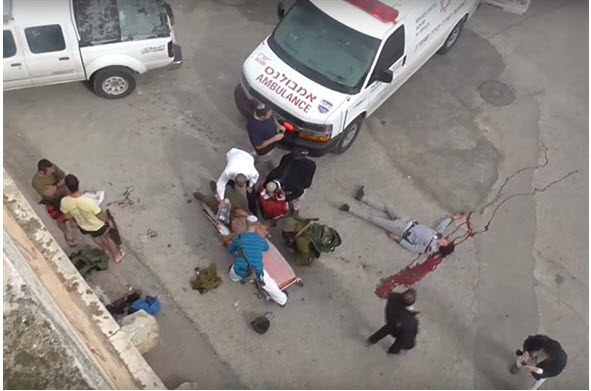After footage released in March by the human rights organization B’Tselem sparked outrage over the execution-style killing of a Palestinian by an Israeli soldier, in a statement made by the NGO on Monday, June 6, it revealed that witnesses to the incident claim that the second Palestinian killed in the incident was also shot in the head.
In its statement, B’Tselem said it had spoken with two witnesses from the Tel Rumeida area of the southern occupied West Bank city of Hebron, where Abd al-Fattah al-Sharif and Ramzi Aziz al-Qasrawi, both 21, were shot and killed after the two allegedly stabbed and moderately wounded an Israeli soldier at a military checkpoint on March 24. A graphic video released by B’Tselem captured the moment when Israeli soldier Elor Azarya shot al-Sharif, who was lying wounded on the ground, in the head, killing him.

The body of Palestinian Ramzi al-Qasrawi who was killed by Israeli forces in Hebron on March 24, 2016 (Photo: B’Tselem)
The footage of al-Sharif’s death was met with wide condemnation from Israeli and Palestinian rights groups, Hadash MKs and international bodies, with the UN and Amnesty International demanding an investigation into al-Sharif extrajudicial execution by the soldier. However, according to information collected by a B’Tselem field researcher, testimony from Tel Rumeida residents regarding the death of al-Qasrawi, who was killed before al-Sharif, “raise concerns that al-Qasrawi was also executed with a shot to the head, as he lay wounded on the ground after having been hit by gunfire elsewhere in his body.”
According to two eyewitnesses, the B’Tselem statement added, “after both al-Sharif and al-Qasrawi were lying wounded on the road, clearly posing no danger to anyone, and even before additional troops and the paramedics arrived on the scene, a soldier (or officer) went up to al-Qasrawi and shot him twice in the neck or head from several meters away.” New video footage surfaced on Wednesday, June 1, showing an Israeli ambulance driver kicking a knife towards al-Sharif’s body, in what apparently constituted tampering with evidence at the scene. The presence of this knife has been used to bolster claims by Azarya that al-Sharif constituted a threat at the time of his death.
The trial of Azarya, the Israeli solder accused of manslaughter, opened in May, but strong expressions of support he has received from the Israeli public, including prominent political figures, have raised fears among Palestinians that the soldier will evade any meaningful consequences for the killing. In a recent report released by B’Tselem, the Israeli human rights group stated that out of 739 complaints on human rights abuses committed against Palestinians which were submitted to Israeli military bodies, only 3 percent resulted in charges being brought against soldiers.
Furthermore, the two eyewitness accounts of al-Qasrawi’s death revealed by B’Tselem this week also cast further doubts on claims by the Israeli army that al-Sharif’s killing was a lone incident, and does not reflect the military’s regular code of conduct. “There have been many reports since October of a policy permitting shoot-to-kill in incidents in which Palestinians harmed, or attempted to harm, Israeli security personnel or civilians, even when there is no clear and immediate mortal danger, or if the danger can be overcome without resorting to a lethal outcome,” B’Tselem wrote. “Nevertheless, to date, these cases are hardly ever investigated, and no civilian or member of the security forces has faced charges for implementing his policy. The case of Sgt. Azaria, whose trial is still underway, is the one exception,” the organization added. “But what is far more serious is that this open-fire policy has the full backing of senior civil and military officials. Israeli law enforcement authorities, both military and civilian, prefer not to deal with these cases, instead, shutting their eyes to this reality, thereby granting it legitimacy and enabling it to carry on.”
Related:


